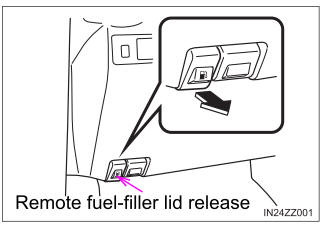Toyota Yaris: Starting the Engine / Engine Start Function When Key Battery is Dead
If the engine cannot be started due to a dead key battery, the engine can be started using the following procedure:
- Continue to depress the brake pedal firmly until the engine has completely started.
- Manual transaxle: Continue to depress the clutch pedal firmly until the engine has completely started.
- Make sure that the push button start indication light (green) flashes.
The push button start indicator light (green) will flash even if the push button start is pressed before depressing the clutch pedal (manual transaxle) or the brake pedal (automatic transaxle). If the clutch pedal is depressed (manual transaxle) or the brake pedal is depressed (automatic transaxle) under this condition, the engine can be started by resuming the procedure following this.
- Touch the push button start
using the backside of the key
(as shown) while the push button start indicator light (green)
flashes.
When touching the push button start using the backside of the key as shown in the illustration, touch the push button start with the lock switch side of the key facing up.

- Make sure that the push button start indicator light (green) turns on.
- Press the push button start to start the engine.
- The engine cannot be started unless the clutch pedal is fully depressed (manual transaxle) or the brake pedal is fully depressed (automatic transaxle).
- If there is a malfunction with the push button start function, the push button start indicator light (amber) flashes. In this case, the engine may start, however, have the vehicle checked at your Toyota dealer as soon as possible.
- If the push button start indicator light (green) does not illuminate, perform the operation from the beginning again. If it does not illuminate, have the vehicle checked at your Toyota dealer.
- To switch the ignition position without starting the engine, perform the
following operations after the push button start indicator light (green) turns on.
- Release the clutch pedal (manual transaxle) or brake pedal (automatic transaxle).
- Press the push button start to switch the ignition position. The ignition switches in the order of ACC, ON, and off each time the push button start is pressed. To switch the ignition position again, perform the operation from the beginning.
NOTICE
When starting the engine by holding the smart key over the push button start due to a dead key battery or a malfunctioning key, be careful not to allow the following, otherwise the signal from the key will not be received correctly and the engine may not start.
- Metal parts of other keys or metal
objects touch the key.

- Spare keys or keys for other vehicles
equipped with an immobilizer system
touch or come near the key.

- Devices for electronic purchases, or security passage touch or come near the key.
 Starting the Engine
Starting the Engine
Make sure you are carrying the key.
Occupants should fasten their seat belts.
Make sure the parking brake is on.
Continue to press the brake pedal firmly until the engine has completely
started...
 Emergency Operation for Starting the Engine
Emergency Operation for Starting the Engine
If the KEY warning light (red) illuminates, or the push button start
indicator light (amber) flashes, this could indicate that the engine may not
start using the usual starting method...
Other information:
Toyota Yaris XP210 (2020-2025) Reapir and Service Manual: Coolant
C..
Toyota Yaris XP210 (2020-2025) Reapir and Service Manual: Bleeding
BLEEDING CAUTION / NOTICE / HINT NOTICE: Move the shift lever to P and apply the parking brake before bleeding the brakes. Add brake fluid to keep the level between the MIN and MAX lines of the reservoir while bleeding the brakes. If brake fluid leaks onto any painted surface, immediately wash it off...
Categories
- Manuals Home
- Toyota Yaris Owners Manual
- Toyota Yaris Service Manual
- How to use USB mode
- Headlights
- How to connect USB port/Auxiliary jack
- New on site
- Most important about car
Refueling
Before refueling, close all the doors, windows, and the liftgate/trunk lid, and switch the ignition OFF.
To open the fuel-filler lid, pull the remote fuel-filler lid release.

